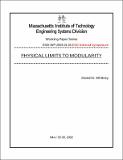| dc.description.abstract | Architecture, specifically the definition of modules and their interconnections, is a central concern of engineering systems theory. The freedom to choose modules is often taken for granted as an essential design decision. However, physical phenomena intervene in many cases, with the result that 1) designers do not have freedom to choose the modules, or 2) that they will prefer not to subdivide their system into as small units as is possible.
A distinction that separates systems with module freedom from those without seems to be the absolute level of power needed to operate the system. VLSI electronics exemplify the former while mechanical items like jet engines are examples of the latter. It has even been argued that the modularity of VLSI should be extended to mechanical systems. This paper argues that there are fundamental reasons, that is, reasons based on natural phenomena, that keep mechanical systems from approaching the ideal modularity of VLSI. The argument is accompanied by examples. | en_US |
